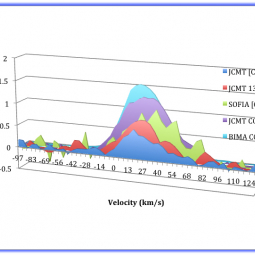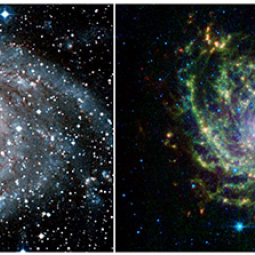SOFIA made observations of ionized carbon (CII) at the center of IC 342 galaxy using the GREAT (German REceiver for Astronomy at Terahertz frequencies) far-IR spectrometer in September 2011 as part of the mission’s Early Science program.
IC 342 (see figure) is a gas-rich spiral galaxy about 11 million light-years away in the direction of the constellation Camelopardalis, The Giraffe. IC 342 has very active star formation in its nucleus plus strong velocity gradients indicating violent gas motions. Observations with the GREAT instrument, a high-resolution spectrometer onboard SOFIA were made to study the energy budget of the star formation burst in IC 342.
IC 342 has a central molecular ring surrounding a massive nuclear star cluster with stars actively being formed and strong far-ultraviolet (FUV) radiation. In IC 342 the strong FUV radiation illuminates the central molecular ring, producing prominent PDRs (Photo-Dissociation Regions; nebulae of ionized gas) on the side of the ring facing the central cluster.
SOFIA/GREAT observations of the singly ionized carbon [C II] spectral line at 158 microns show a relatively broad profile (48 km/s width; Figure 2) with separate peaks at velocities of 24 and 50 km/s. The GREAT spectra, combined with measurements from other observatories, allow separation of the cloud material into two regions. The first region is a strongly excited starburst/PDR region with high gas density. The second region is a cool molecular region with a lower density. The two regions show both ionized carbon and carbon monoxide (CO) emission. These observations include an unexpected result that the carbon line emission in IC 342 is associated with high-density as well as relatively low-density clouds. This means that the ultraviolet radiation in IC 342’s nucleus is intense enough to ionize atoms even in dense clouds.
Detailed information can be found in the paper by M. Röllig et al. 2012 , Astronomy & Astrophysics, 542, L22.

